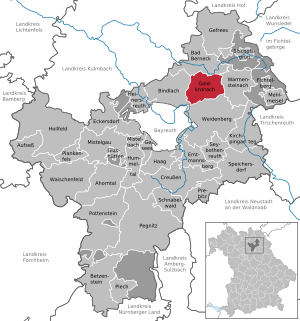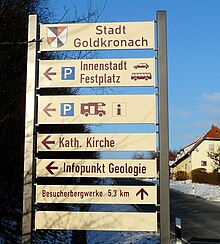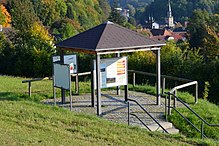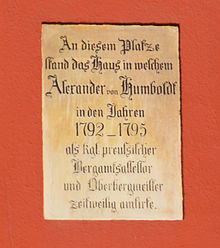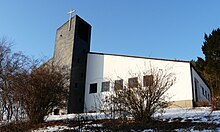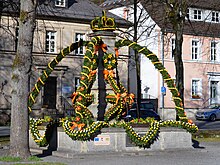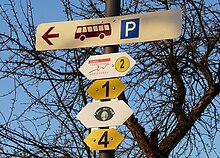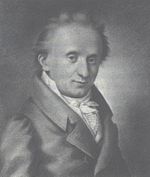Goldkronach
| coat of arms | Germany map | |
|---|---|---|

|
Coordinates: 50 ° 1 ' N , 11 ° 41' E |
|
| Basic data | ||
| State : | Bavaria | |
| Administrative region : | Upper Franconia | |
| County : | Bayreuth | |
| Height : | 443 m above sea level NHN | |
| Area : | 30.67 km 2 | |
| Residents: | 3469 (Dec. 31, 2019) | |
| Population density : | 113 inhabitants per km 2 | |
| Postal code : | 95497 | |
| Area code : | 09273 | |
| License plate : | BT, EBS , ESB , KEM , MÜB , PEG | |
| Community key : | 09 4 72 143 | |
| LOCODE : | DE GCC | |
| City structure: | 29 districts | |
City administration address : |
Marktplatz 2 95497 Goldkronach |
|
| Website : | ||
| Mayor : | Holger Bär (FWG) | |
| Location of the town of Goldkronach in the Bayreuth district | ||
Goldkronach ( Franconian Gronich ) is a town in the Upper Franconian district of Bayreuth . The state-approved resort is located at the foot of the Fichtelgebirge about 14 kilometers northeast of the district town of Bayreuth . The city experienced its first heyday in the Middle Ages with gold mining, which was not finally stopped until the 1920s.
Name, coat of arms and flag
Goldkronach was originally called "Cronach" or "Kranach". While the first part of the name was undoubtedly added later and refers to the rich precious metal deposits, the second, older part is probably of Slavic origin. It probably dates from the time up to the 10th century, when Slavic or Sorbian influences played a role in the settlement of what is now the Upper Franconian district. The dialect expression “Gronich” is probably derived from this older part of the name. In recent times, and especially among young people, the nickname “Gold City” has also been found. The oldest known seal in the city dates from 1559. In the legend SIGILLVM OPPIDI GOLTCRONACH there is a square shield: In fields 1 and 4 a silver crown set with gemstones, in 2 and 3 the tariff address . Even today the coat of arms is quartered; 1 diagonally divided by black and silver; 2 and 3 obliquely to the left divided by red and silver, each with a golden royal crown in red; 4 diagonally divided by silver and black. The reference to the Zollernvierung remained with the black and white diagonal division, the golden crowns stand for the name of the city. The flag of the town of Goldkronach is red and gold, and the coat of arms is added to it.
geography
Geographical location
Goldkronach is located on the Kronach , which flows through the urban area from southeast to northwest . It rises with several source streams west of Warmensteinach . The Kronach shapes the market square of the main town, in earlier times it drove two water mills via the specially constructed Mühlbach and flows into the White Main at Himmelkron . While there are agricultural areas in the flatter south and west of the municipality, especially in the Kronach Valley, the mostly wooded heights in the north and east mark the ascent to the Fichtel Mountains.
Geology and gold deposits
Goldkronach lies directly on the Franconian Line , a geological fault. It separates the geologically much older, hard rocks of the Fichtelgebirge from the younger, soft rocks of the foreland. At this fracture in the earth's crust, one of the most important tectonic fracture zones in Europe, the foreland floe sank, while that of the Fichtelgebirge rose. This results in the remarkable situation that in the Goldkronach city area, rock types from several geological periods can be found on the surface.
The gold deposits can be traced back to these geological faults. You are limited to a small area around the Goldberg . Presumably they originated from sediments and lava rocks with a low gold content. An exact dating of the gold mineralization is still pending. However, it is likely that the gold quartz veins on the Goldberg are related to the formation of the Alps in the Cretaceous period . For a few years now, information about the history of the earth has been provided by the Goldkronacher geopoints , which were established by the city in cooperation with the Geopark Bavaria-Bohemia and the Fichtelgebirge wellness region. Guided tours are also offered.
City structure
The city has 29 districts :
|
|
There are the districts Brandholz, Dressendorf, Goldkronach, Leisau and Nemmersdorf.
Neighboring communities
The city borders on the following cities, municipalities and unincorporated areas (starting in the north, following clockwise): Bad Berneck in the Fichtelgebirge , Weidenberg , Bayreuth and Bindlach .
Geotopes
- Moosmüller-Keller in Goldkronach (geotope number 472A012).
- Former quarry on the Otterleite near Goldkronach (geotope number 472A013).
- Rotliegend cellar under Nemmersdorf Castle (geotope number 472A014).
- Kellergasse Goldkronach (geotope number 472A017).
- Schmutzler tunnel east of Goldkronach (geotope number 472G003).
- Frankenberg diabase rock near Brandholz (geotope number 472R002).
history
First settlement and start of mining
The first documentary mention of Goldkronach goes back to a fiefdom list that was made in 1317. It lists places in the region that existed before the bishopric of Bamberg was founded in 1007 - including the "dorf kranach". So it is likely that the first settlement arose before the year 1000 on the old trade route to Bohemia.
There is evidence of mining as early as the 13th century. Everywhere in the Fichtel Mountains people dug for tin , silver , iron - and gold . Goldkronach, which like the entire area belonged to the property of the Counts of Andechs , was assigned the most profitable area of the empire at Goldberg and Zoppatenbach. Since then, the history of the place has been closely interwoven with mining. Via the counts of Orlamünde , a noble family with Thuringian roots, the Zoller burgraves of Nuremberg gained control of the place and the castle that existed at that time, the Veste Goldeck.
The prosperity of mining and urban elevation
The village of cranach or kranach became increasingly important due to the mining of precious metal deposits. Burgrave Friedrich V raised the place to a city on September 29, 1365. At the same time, he admitted the assumption of Iglauer Bergrecht - the so-called mountain freedom . According to this document, resident and future settlers should receive "protection and protection, freedom and rights regardless of the person, whether poor or rich". The first written evidence of the name Goldtkranach comes from the year 1398 . In Bayreuth and Schwabach gulden were minted from Goldkronacher gold.
The modest prosperity that the economic boom brought with it is reflected in the chapel, built in 1413, which - like its successors - was dedicated to St. Erhard. The last remaining remnant is integrated into the entrance area of the church building from the 19th century. Gold mining was in its prime from the middle of the 14th century to the middle of the 15th century. Goldsmiths from Bamberg , Nuremberg or Erfurt owned shares in the Goldkronach mines and processed the coveted raw material.
With the Hussite Wars , however, mining came to a standstill, at the latest when the Hussites plundered through Goldkronach in 1430 and destroyed the St. Jobst monastery on the Oschenberg . The 1470s are of relevance to church history: after the Goldkronach parish was officially separated from the Nemmersdorf mother church in 1474, the chapel had become too small. In 1477 the residents built the first larger church, which was to be replaced in 1737 due to its dilapidation. The solution from the Nemmersdorf community was completed in 1580.
The major fires in 1559 and 1613 meant catastrophes in the development of the city, before the Thirty Years' War brought gold mining to a temporary standstill again. A striking point in the city's history was the year 1655, when citizens took over the municipal administration for the first time through four mayors and eight councilors. In the meantime the Franconian areas of the Hohenzollern had become the margravates of Ansbach and Bayreuth . After resuming mining more intensively from 1662 onwards, Margrave Christian Ernst had mining ducats minted after a few years.
Alexander von Humboldt
In 1792, the central Prussian administration took over the territory of the previously independent principalities of Ansbach and Bayreuth. Goldkronach mining had meanwhile almost come to a standstill after the yields had fallen sharply. The Berlin administration sent 23-year-old Alexander von Humboldt to check the state of the city and the mines. He reported to the responsible ministry and subsequently stayed as chief miner in Goldkronach to revive the mining industry using new technology.
However, his activities were not limited to organizational and technical innovations in the process of precious metal mining. In Goldkronach - as in the entire Fichtelgebirge - Humboldt's name is associated with improvements for the miners and their families. This included the rifle money for the widows of accident victims as well as the now much safer and healthier working conditions in the pits and tunnels. In 1796, Humboldt resigned from the civil service in order to travel. With Otto Heinrich Tornesi, a son of the city succeeded him. Both had previously worked closely together.
Prussia still minted gold ducats from Goldkronacher gold in 1803. An impression of how contemporaries experienced the city on the threshold of the 19th century is provided by the description of the Royal Prussian Parish Goldkronach, penned by Johann Georg Dürrschmidt. “The inhabitants are mostly strong and healthy people and have a comfortable and urban appearance, and especially the praise for turning their mountains into fertile fields. Their houses, although very few are massive, look very good; the alleys are fairly straight, free of dung heaps, but not […] paved ”, he described in 1800. In fact, the wooded heights around the town were used for agriculture in earlier times.
Under Bavarian rule
With the Prussian areas of Ansbach and Bayreuth, the city fell to France in the Peace of Tilsit in 1807, which ended the Fourth Coalition War . The French rulers assumed low yields and therefore had no interest in ore mining. Just three years later, Napoleon sold the former Principality of Bayreuth to his ally, the now Kingdom of Bavaria, for 15 million francs . Many residents of the formerly independent territories that were annexed to the Bavarian state in those years disliked the new masters. The fact that the Bavarian state initiated the re-commissioning of the mines in 1828 probably helped to alleviate this on site.
In 1855 Bavaria even minted gold ducats from these mines with the likeness of Maximilian II. On June 24, 1836, Goldkronach suffered the last major fire disaster. The entire eastern part of the city fell victim to the fire, a total of 127 families lost their homes, both school houses and the town hall were also destroyed. Goldkronach was able to be rebuilt with help from surrounding cities, from Bayreuth, Würzburg , Wunsiedel and Nuremberg . Many of the houses in the town center that exist today were built in 1836 and 1837; the listed ensemble of the market square and the street scene therefore show clear features of the Biedermeier period . The current town church of St. Erhard was also built after this fire. The foundation stone was laid in 1841, and the church was consecrated eleven years later.
Final end of gold mining
Falling yields meant the end of gold mining in 1861. In 1907 a new mining company was formed, which was transferred to Fichtelgold AG on June 28, 1920 . This resumed production, so at the beginning of the 1920s, a good hundred people were directly employed in mining in Goldkronach. Favorable and daring forecasts made the Fichtelgold share an object of speculation. Just a few years after the company was founded, however, Fichtelgold's financier, the Stuttgart bank Wittmann, ran into financial difficulties. The value of the share plummeted and mining had to be abandoned despite recent earnings. In 1925 the operation of the production in the district of Brandholz ended. Further attempts in the 1920s and 1930s failed. Test drillings made headlines again between 1974 and 1977 - however, mining in Goldkronach did not resume.
History of the districts
Firewood
The long history of mining left its clearest traces in the Brandholz district, which can be seen in the visitor mine of the Middle Name of God . The Fürstenzeche, which Dürrschmidt mentioned in 1800, was also located in the village; the building of the former mining authority has been preserved. Brandholz was incorporated on May 1, 1978.
Dressendorf
Little is known about the history of the district. However, frequent changes of name of this municipality are documented: In 1487 the village was listed as "Trebssenndorff", in 1495 as "Tresendorff", in 1503 as "Trebßendorff" and in 1523 as "Drebssendorff". The district has been known as Dressendorf since 1875 and was incorporated on January 1, 1972.
Leisau
As early as 1800, Leisau had a total of 124 inhabitants. The castle, which probably dates from the 17th century and was probably the center of a small manor, is characteristic of the townscape. The place became on January 1, 1976 Goldkronacher district.
Nemmersdorf
The history of Nemmersdorf can be traced back to 1149. The village is named after its probably first owner, Friderich von Nedemarestorf. It first fell to the Diocese of Bamberg before it belonged to the Counts of Orlamünde, like Goldkronach. The different twin towers of the Evangelical Lutheran Church, which are also located on the two narrow sides of the nave, are characteristic of the townscape . Nemmersdorf was incorporated on July 1, 1972 and is the district with the second highest population after the main town of Goldkronach.
Population development
In the period from 1988 to 2018, the city grew from 2961 to 3487 by 526 inhabitants or 17.8%.
- 1961: 2945 inhabitants
- 1970: 2935 inhabitants
- 1987: 2903 inhabitants
- 1991: 3052 inhabitants
- 1995: 3435 inhabitants
- 2000: 3598 inhabitants
- 2005: 3704 inhabitants
- 2010: 3630 inhabitants
- 2015: 3536 inhabitants
politics
Since 1655 the political leadership of the city has been incumbent on the citizens. Today, a full-time mayor and 16 honorary city councilors are elected in local elections. Around ten field jury members are also part of the local self-government in Goldkronach . In Schulverband Bad Berneck, which belongs to the municipality, it represents two school boards association and two deputies. In addition, it sends representatives to the council of the relevant association from those districts that are partly supplied by the so-called Benker Group .
Mayor and City Councilor
The first mayor is Holger Bär (FWG). He prevailed in the 2014 local elections as the candidate of the Free Voters in the runoff election against Günter Exner from the UBL. The SPD applicant failed in the first ballot.
After the 2014 local elections, the following parties and constituencies are represented in the city council:
- SPD (2 seats)
- CSU (2 seats)
- Free voters (5 seats)
- Independent citizen list (4 seats)
- List of women (1 seat)
- Alternative list of citizens (1 seat)
- Non-party voters Brandholz (1 seat)
In the current legislative period, the city council is forming three committees, the building and environment committee with eight members, the auditing committee and the youth, senior and main administrative committee with six members each. With the exception of the Audit Committee, the chairman of the committees is the full-time mayor. The finance and personnel committee was dispensed with in the new legislative period in order to better integrate the nine lists. The free voters in the city council are made up of representatives of the electoral community Goldkronach, the electoral community Dressendorf and the Nemmersdorf civic bloc. The independent citizens 'list and alternative citizens' list Nemmersdorf-Dressendorf, like the Free Voters, joined the list and now form a parliamentary group.
Goldkronach has been considered a "red" stronghold for decades because of the - not only in local elections - in regional comparison the clearly strong SPD and weak CSU. This was still reflected in the reports in the local press about the acquisition of the Goldkronach Castle by the CSU politician Hartmut Koschyk . A correlation with the historical economic structure of Goldkronach can be assumed, but has hardly been investigated. The latest election results made this reputation suffer anyway; rather, there was a high level of volatility, especially in local elections.
Town twinning
-
 : The town of Goldkronach has had a partnership with the community of Grünbach in the Saxon Vogtland district since September 1990 .
: The town of Goldkronach has had a partnership with the community of Grünbach in the Saxon Vogtland district since September 1990 . -
 Czech Republic : There has also been a partnership with the city of Žacléř since May 2001 . Žacléř, which is located in the north of the Czech Republic in the Rehorn Mountains , a foothill of the Giant Mountains , can also look back on a long mining tradition.
Czech Republic : There has also been a partnership with the city of Žacléř since May 2001 . Žacléř, which is located in the north of the Czech Republic in the Rehorn Mountains , a foothill of the Giant Mountains , can also look back on a long mining tradition.
religion
The population of Goldkronach is predominantly Protestant . In the city there are two Evangelical Lutheran parishes in Goldkronach and Nemmersdorf and one Catholic parish.
The Evangelical Lutheran parish of Goldkronach maintains the town church, where the Sunday services and concerts take place. The first chapel on the site of today's town church was built in 1413, the first larger church in 1481. The neo-Gothic hall church with portal tower was consecrated in 1852. In the immediate vicinity are the parish office and the parish stalls , which are used, for example, for the children's Bible week and confirmation classes. The community library is also located there. There is also the cemetery church, built in 1765, and the Bruckmühle parish hall. The Evangelical Lutheran congregation in Nemmersdorf celebrates its services in the parish church of Our Lady , whose east tower can be dated to the 13th century. The interior is from the Rococo period .
The Catholic Church on Leisauer Berg was built between 1966 and 1967 and is dedicated to Saint Michael . The Evangelical Lutheran congregation had previously made the cemetery church available.
Economy and Infrastructure
While the first inhabitants lived from agriculture, gold mining determined economic life in Goldkronach and its surroundings from around 1300 until the 19th century. After that, companies from a wide variety of industries developed, and the city also benefits from its proximity to Bayreuth and fast transport connections to Nuremberg or Bamberg and thus became the home of many commuters. To strengthen the regional economy, the regional money Fichtelgold was introduced in Goldkronach and Bad Berneck .
statistics
In Goldkronach in 2009 there were 637 employees subject to social insurance contributions at the place of work and 1,363 employees subject to social insurance contributions at the place of residence. Among those employed in the urban area, those working in the manufacturing sector formed the largest group (401 in total). According to the latest publications by the State Office for Statistics and Data Processing, there are 37 farms in Goldkronach with a usable area of more than two hectares. Five companies are active in manufacturing or mining, as many in construction .
Industries and companies
The larger companies in Goldkronach include Lufttechnik Bayreuth (environmental technology), SMB Schwede Maschinenbau (strapping technology), Bella curtain manufacture (textiles) and hbk (metal processing). They are spread across the industrial areas in the south of the city and in the Sickenreuther Valley. In the inner city it has so far been largely possible to maintain the economic structures. In addition to restaurants, bakeries and butchers, there is an interior decorator, stationery shops and a grocery store. The plans to build a new supermarket just outside the city met opposition in the run-up to the 2008 local elections.
Goldkronacher talks
The Goldkronacher Talks on regional and municipal development is a series of talks organized by the Technical University of Kaiserslautern and the Technical University of Chemnitz . The Goldkronach Talks take place annually with the aim of offering regions and municipalities solutions for coping with demographic change and economic structural changes. The project's cooperation partner is Hartmut Koschyk , former Parliamentary State Secretary in the Federal Ministry of Finance . The CSU politician lives in the Goldkronach Castle and makes the building available as an event location.
care
The water supply is provided by the municipality itself and the water supply association of the Benker Group , to which the city belongs. The sewage treatment plant is located in the Kottersreuth district. As the center of municipal tasks such as winter maintenance or green maintenance , the city operates a building yard in Peuntgasse, which also serves as a recycling center.
communication
There is a post office on the marketplace. In the past few years, the city administration has pushed ahead with the expansion of Internet broadband coverage , as it believes that Goldkrona lacked DSL connections with adequate speeds. She hoped that this would not only provide a better connection for the citizens, but above all a higher quality location for businesses. A speed of 16,000 kbit / s has been possible since December 2011 .
Health and public safety
Two general practitioners and a dentist practice in Goldkronach. There is also a pharmacy and a retirement home. In the main town and in the districts of Dressendorf, Brandholz, Kottersreuth, Leisau, Nemmersdorf and Sickenreuth there are volunteer fire departments .
traffic
Road traffic
State road 2163, which connects Middle Franconia and Franconian Switzerland with the Fichtel Mountains and ends with the connection to federal road 303 (B 303), runs through Goldkronach . This crosses the B 2 in the neighboring municipality of Bad Berneck and continues as the Fichtelgebirgsstraße into the high Fichtelgebirge and into the Czech Republic . The federal autobahn 9 (A 9) between Berlin and Nuremberg can be reached either via the Bindlacher Berg driveway eight kilometers away or the Bayreuth-Nord driveway nine kilometers away. The Bayreuth / Kulmbach motorway triangle is also located at the Bindlacher Berg driveway , where the A 70 begins via Bamberg to Schweinfurt .
Public transportation
Goldkronach has been part of the greater Nuremberg area since January 2010 and can be reached with the Frankenbus lines 329, 330 and 368. In the urban area there are the stops Brandholz, Dressendorf, Goldkronach (on the market square), Nemmersdorf Ort, Zoppaten and the Nemmersdorf junction, the latter is in the immediate vicinity of the residential area at Weizbühl. The buses each stop at Bayreuth Central Station, which ensures the connection to local and long-distance transport of Deutsche Bahn . In order to ensure accessibility by public transport even late in the evening, a subsidized collective call taxi operates from Monday to Friday and on Sundays. On Saturday evening and on Sunday night, Goldkronach is served by the Bayreuth district leisure bus. This offers young people in particular the opportunity to get to Bayreuth or to events in the region at low cost.
Citizen bus
The Citizen Bus Goldkronach has existed since 2011, which connects the districts with the city center once a week according to a fixed timetable. The city administration's offer is aimed primarily at senior citizens and people without their own vehicle. Initially, the model is to be tested for six months.
Education and culture
Alexander von Humboldt School
The Alexander von Humboldt School is a primary school with lunchtime and all-day care and runs up to the fourth grade. It was also a secondary school until 2008, since then the pupils from the fifth grade attend the middle school in the neighboring town of Bad Berneck , a grammar school or a secondary school in Bayreuth. The Alexander von Humboldt School is the coordinating school of the Comenius Program of the European Union and was awarded the Bavarian European Certificate in 2011 for its commitment to European networking through eTwinning , a digital school network. Numerous events of the Goldkronach adult education center also take place in the school premises .
Kindergartens
In the urban area there are the two kindergartens Mäusenest in the Goldkronacher Bachgasse, the institution is supported by the Protestant church, and Wichtelschiff in Reuther Straße in Nemmersdorf.
Architectural monuments
Gold mining museum and mines
The Goldkronach Gold Mining Museum was opened in 2004 in the former official building of the State Forestry Administration. It shows the history of gold mining, changing special exhibitions and the city's history. Before that there was a local history museum in Goldkronach, the holdings of which were integrated into the new museum. A tour leads through the individual rooms and thematic complexes, such as the geology of the Fichtelgebirge, panning for gold, alchemists, gold processing and the myth of gold or the mines around Goldkronach. A replica tunnel illustrates the atmosphere underground. With the Schmutzlerschacht and the visitor mine Middle Name of God (see visitor mines Goldkronach ) there are two former mines that can be visited. You can wash gold yourself at the nearby information center .
Culinary specialties
In Goldkronach there is a specialty that can only be found here, the so-called Zutenhefe dumplings, in the local dialect "Zudnhefferglies". These are dumplings made from flour and potatoes, fried in clarified butter. Served with “gebrodna Rippla” (fried peeled ribs ) and sauerkraut , they are a typical Goldkronach Christmas dinner .
Regular events
- Goldkronach cultural summer of the Alexander von Humboldt Cultural Forum with concerts, lectures and cinema in the castle
- Parish fair (“Kerwa”) and market on the fourth Sunday in October, as well as spring parish fair and parish fair in the districts
- Christmas market on the first Sunday of Advent
- "Kanzfeuer" on St. John's Day
- Market Square Festival in July or August
- Museum, fire brigade and club festivals
freetime and sports
Soccer
In Goldkronach there are two sports clubs with a football department. The SpVgg Goldkronach, which rose to the fourth class Second Amateur League in 1960, currently plays in the district class. It traces its tradition back to the workers' gymnastics and sports club Vorwärts Goldkronach, which marked the beginning of organized sports in Goldkronach after the First World War . In the 1920s there was also the FC Goldkronach, which was more likely to be assigned to the middle-class milieu. In 1946 Vorwärts Goldkronach was re-established as a singing and sports club, later merged with SV Brandholz and has been called SpVgg Goldkronach since 1951. The city's second football club, ASV Nemmersdorf, has been playing in the district league since the celebrated championship in the 2015/2016 season. Although there is a pronounced rivalry between the two clubs, their football departments jointly conduct youth work in the Fichtelgebirge youth development association, which also includes other clubs from the surrounding area, as well as selectively in the association of reserve teams since 2016.
Bowling
The Goldkronach bowling club won the runner-up in the Third Bundesliga South in 2012 with their first men's team and so returned to the Second Bundesliga after a few years of abstinence. The first women's team plays in the district league A East, the youth teams in the district class East. The bowling alley is on Leisauer Strasse.
Shooting sports
The shooting club ZSG 1909 Goldkronach is active in the Gauliga. The Goldkronach shooters were particularly successful in the 1970s, when the first team managed to march through from the C-class to the district league. In 1984 the main shooting of the Schützengau Oberfranken-Süd took place in Goldkronach.
swim
The Goldkronach bathing lake, which is suitable for bathing and swimming, is located between Weizbühl and the district of Kottersreuth.
hike
There are numerous hiking trails and marked routes in and around Goldkronach. The Humboldtweg, on which the city administration also offers guided tours, opens up around 40 stations in the area of the former gold mining area with visible evidence of mining history. The Franconian Mountain Trail and the Jean-Paul-Weg lead through the urban area.
Winter sports
Favored by its location on the ascent to the Fichtel Mountains, Goldkronach offers a range of sports opportunities in winter. In the winter of 2011, the city set up a groomed trail entrance on the Goldberg, via which many cross-country skiing routes in the Fichtelgebirge can be reached. The bathing lake is used for ice skating, ice stock sport and ice hockey in the cold season. A ski jump existed on Mühlhügel in the 1960s and SpVgg Goldkronach was expanded with a winter sports department. The operation of the ski lift in the Schlegelberg district ceased at the turn of the millennium, and locals and guests took advantage of the opportunity to pursue alpine skiing in the high Fichtel Mountains.
Other sports
A number of other sports are practiced in the local clubs. These include tennis at Tennisfreunde Goldkronach and ASV Nemmersdorf , karate and gymnastics at SpVgg Goldkronach and table tennis at ASV . A beach volleyball field has been set up on the grounds of the tennis fans .
Personalities
sons and daughters of the town
- Friedrich Layriz (* 1808 in Nemmersdorf, † 1859 in Unterschwaningen ), Evangelical Lutheran pastor and hymnologist
- Samuel Wilhelm Oetter (* 1720 in Goldkronach, † 1792 in Markt Erlbach ), heraldist and Count of the Palatinate
- Eva Margareta Reichel (* 1824 in Goldkronach; † 1885 in Kulmbach ), née Pöhlmann, took over the management of the Reichelbräu (today's Kulmbacher brewery ) after the death of her husband in 1857 .
- Sigismund von Reitzenstein (* 1766 in Nemmersdorf; † 1847 in Karlsruhe ), Baden diplomat and politician
Personalities who lived and worked in Goldkronach
- Georgius Agricola (* 1494 in Glauchau , † 1555 in Chemnitz ), scholar of the Renaissance and "father of mineralogy ". Agricola named a weekly gold yield of 1500 guilders for Goldkronach in his writings . Petrus Albinus cited the information in 1598 in the Meißnische Bergchronik .
- Alexander von Humboldt (* 1769 in Berlin ; † 1859 there), German naturalist, from 1792 to 1796 chief miner and upper mountain ridge in Goldkronach, Prussia. Humboldt revolutionized mining in technical terms, but also introduced measures for education and social security for miners. A self- experiment in bad weather nearly cost him his life in the last year of his stay. On January 20, 1794, he wrote to his friend Johann Carl Freiesleben : "In Goldkronach in particular, I am happier than I dared to believe!"
- Hartmut Koschyk (born April 16, 1959 in Forchheim ), politician (CSU), Member of the Bundestag since 1990 , owner of Goldkronach Castle, October 2009 to December 2013 Parliamentary State Secretary in the Federal Ministry of Finance, initiator of the Goldkronach Talks
Others
- Goldkronach was the setting for a television game of the same name ( ZDF / Telenorm 1985) with Michael Roll . According to the script by Fitzgerald Kusz , a journalist claims to have struck gold and thus triggers a new gold rush in Goldkronach.
See also
literature
- Johann Kaspar Bundschuh : Goldcronach . In: Geographical Statistical-Topographical Lexicon of Franconia . tape 2 : El-H . Verlag der Stettinische Buchhandlung, Ulm 1800, DNB 790364298 , OCLC 833753081 , Sp. 358-359 ( digitized version ).
- Ingrid Burger-Segl: Goldkronach Gold Mining Museum , Weiden 2011.
- Radu Chinta: Historical overview of the Goldkronach ore mining , Geologische Blätter für Nordost-Bayern 32, Heft 3–4, Erlangen 1982.
- Johann Georg Dürrschmidt: Description of the royal Prussian parish Goldkronach located in the Principality of Baireuth in statistical, topographical, historical, oryctological and literary terms , Bayreuth 1800. ( full text )
- Gerhard Fellner (Ed.): Nemmersdorf - Contributions to the local history of a village in the Fichtelgebirge , Bayreuth 1999.
- Joachim Gawlik: Geology of the foreland of the Franconian Line between Goldkronach and Neuenmarkt , Erlanger geologische Abhandlungen 18, Erlangen 1955.
- Dietmar Herrmann, Helmut Süssmann: Fichtelgebirge, Bavarian Vogtland, Steinwald, Bayreuther Land: Lexikon , Hof (Saale) 2000, p. 214.
- Dietmar Herrmann: 650 years of the city of Goldkronach , in: Siebenstern 2015, issue 5, p. 4.
- Gregor Hofmann: Fichtelgold. Aspects of Goldkronach gold mining in the 20th century , in: Archive for the history of Upper Franconia 95 (2015), pp. 171–193.
- Georg Paul Hönn : Gold Cronach . In: Lexicon Topographicum of the Franconian Craises . Johann Georg Lochner, Frankfurt and Leipzig 1747, p. 252 ( digitized version ).
- Johann Kießling: What houses tell. From the history of Goldkronach , Goldkronach 2003.
- Johann Kießling: What houses tell. From the history of Leisau and Kottersreuth , Goldkronach 2010.
- Johann Kießling: What houses tell. From the history of Sickenreuth and Goldberg , Goldkronach 2005.
- Anna Schiener: Little History of Franconia , Regensburg 2008.
- Pleikard Joseph Stumpf : Goldkronach . In: Bavaria: a geographical-statistical-historical handbook of the kingdom; for the Bavarian people . Second part. Munich 1853, p. 569 ( digitized version ).
- Pleikard Joseph Stumpf : Nemmersdorf . In: Bavaria: a geographical-statistical-historical handbook of the kingdom; for the Bavarian people . Second part. Munich 1853, p. 570-571 ( digitized version ).
- Karl-Georg Wolfshöfer: Malt coffee with milk skin , Weißenstadt 2008.
Web links
- Homepage of the city of Goldkronach
- Entry on the coat of arms of Goldkronach in the database of the House of Bavarian History
Individual evidence
- ↑ "Data 2" sheet, Statistical Report A1200C 202041 Population of the municipalities, districts and administrative districts 1st quarter 2020 (population based on the 2011 census) ( help ).
- ↑ Johann Georg Dürrschmidt: Description of the royal Prussian parish Goldkronach located in the Principality of Baireuth in statistical, topographical, historical, oryctological and literary terms . Bayreuth 1800, p. 48 ( limited preview in Google Book search).
- ↑ Anna Schiener: Brief history of Franconia . Regensburg 2008, p. 33 .
- ^ House of Bavarian History: City of Goldkronach
- ^ Ingrid Burger-Segl: Goldkronach Gold Mining Museum. Weiden 2011, pp. 20–22.
- ^ Ingrid Burger-Segl: Goldkronach Gold Mining Museum. Weiden 2011, p. 23.
- ↑ Landkreis Bayreuth: Bundestag elections 1998 ( Memento of the original from December 27, 2013 in the Internet Archive ) Info: The archive link was inserted automatically and has not yet been checked. Please check the original and archive link according to the instructions and then remove this notice.
- ^ Community Goldkronach in the local database of the Bayerische Landesbibliothek Online . Bayerische Staatsbibliothek, accessed on January 5, 2020.
- ^ Ingrid Burger-Segl: Goldkronach Gold Mining Museum. Weiden 2011, p. 32.
- ^ City of Goldkronach: Goldkronach. Alexander-von-Humboldt-Stadt, Schwabach 2011, p. 19.
- ^ Ingrid Burger-Segl: Goldkronach Gold Mining Museum. Weiden 2011, p. 32.
- ^ City of Goldkronach: Goldkronach. Alexander-von-Humboldt-Stadt, Schwabach 2011, pp. 17-18.
- ↑ Johann Georg Dürrschmidt: Description of the royal Prussian parish Goldkronach located in the Principality of Baireuth in statistical, topographical, historical, oryctological and literary terms. Bayreuth 1800, p. 24.
- ↑ Karl Müssel: Bayreuth in eight centuries . Gondrom, Bayreuth 1993, ISBN 3-8112-0809-8 , p. 139 .
- ^ City of Goldkronach: Goldkronach. Alexander-von-Humboldt-Stadt, Schwabach 2011, pp. 9 and 23.
- ^ Ingrid Burger-Segl: Goldkronach Gold Mining Museum. Weiden 2011, p. 63.
- ^ Ingrid Burger-Segl: Goldkronach Gold Mining Museum. Weiden 2011, p. 40.
- ↑ a b c City of Goldkronach: Goldkronach. Alexander-von-Humboldt-Stadt, Schwabach 2011, p. 11.
- ↑ a b Federal Statistical Office (ed.): Historical municipality register for the Federal Republic of Germany. Name, border and key number changes in municipalities, counties and administrative districts from May 27, 1970 to December 31, 1982 . W. Kohlhammer, Stuttgart / Mainz 1983, ISBN 3-17-003263-1 , p. 675 and 676 .
- ↑ a b Wilhelm Volkert (Ed.): Handbook of the Bavarian offices, communities and courts 1799–1980 . CH Beck, Munich 1983, ISBN 3-406-09669-7 , p. 432 .
- ↑ http://goldkronach.de/images/wahl/472143_000075/index.html ( page no longer available , search in web archives ) Info: The link was automatically marked as defective. Please check the link according to the instructions and then remove this notice.
- ↑ http://www.wahlen.bayern.de/biz/kowa_g2008.php?g=h&schluessel=472&suchbegriff=4
- ↑ City Council. City administration Goldkronach, accessed on August 2, 2020 .
- ↑ Landkreis Bayreuth: Bundestag elections 1998 ( Memento of the original from December 27, 2013 in the Internet Archive ) Info: The archive link was inserted automatically and has not yet been checked. Please check the original and archive link according to the instructions and then remove this notice.
- ↑ http://www.wahlen.bayern.de/biz/kowa_g2008.php?g=h&schluessel=472&suchbegriff=4
- ^ City of Goldkronach: Goldkronach. Alexander-von-Humboldt-Stadt, Schwabach 2011.
- ↑ http://ekg-gok.de/ Evangelisch-Lutherische Kirchengemeinde Goldkronach: About us
- ↑ Archive link ( Memento of the original from April 8, 2013 in the Internet Archive ) Info: The archive link was inserted automatically and has not yet been checked. Please check the original and archive link according to the instructions and then remove this notice. Catholic parish of St. Johannes Nepomuk: St. Michael Goldkronach
- ^ Bavarian State Office for Statistics and Data Processing: Statistics communal 2010. City of Goldkronach, Munich 2011
- ↑ Outstanding infrastructure ( Memento of the original from December 26, 2013 in the Internet Archive ) Info: The archive link was inserted automatically and has not yet been checked. Please check the original and archive link according to the instructions and then remove this notice.
- ↑ http://goldkronacher-gespraeche.de/index.html TU Kaiserslautern / TU Chemnitz: Goldkronacher Talks
- ↑ Ute Eschenbacher: Portrait. Fichtelgebirgsgemeinde Goldkronach. In: Nordbayerischer Kurier, May 21, 2010, p. 31.
- ↑ Goldkronach, December 21, 2011 - Fast Internet for Goldkronach ( Memento from February 9, 2012 in the Internet Archive ) Deutsche Telekom: Fast Internet for Goldkronach
- ↑ Bayreuth leisure bus: network overview
- ^ City of Goldkronach: Mitteilungsblatt Stadt Goldkronach 12 (2011), p. 4.
- ^ Government of Upper Franconia: Upper Franconian Official Gazette. Official announcements of the government of Upper Franconia, the district of Upper Franconia, the regional planning associations and special purpose associations in Upper Franconia, October 24, 2011, p. 133.
- ↑ http://www.schule-oberfranken.de/index.php?sid=92426ed1fd6119128890a26160cdd460&page=12&vsschulid=5653&schulamt=Bayreuth Government of Upper Franconia: Schools in Upper Franconia
- ↑ Archive link ( Memento of the original from January 8, 2012 in the Internet Archive ) Info: The archive link was inserted automatically and has not yet been checked. Please check the original and archive link according to the instructions and then remove this notice. Schools on the Net e. V .: Recognition for eTwinning school
- ^ Ingrid Burger-Segl: Goldkronach Gold Mining Museum . Weiden 2011, p. 15-20 .
- ↑ https://www.youtube.com/watch?v=8IVp0huPp7k Bavarian television: Zuten yeast dumplings from Goldkronach
- ↑ http://genussregion-oberfranken.de/spezialitaeten/spezialitaeten_von_a_z/z/329/zutenhefekloesse/details_39.htm Genussregion Oberfranken: Zutenhefeklße
- ^ Karl-Georg Wolfshöfer: Malzkaffee mit Milchhaut , Weißenstadt 2008, pp. 10-13.
- ↑ A piece of urban and sports history: Our “Gronich”: From ATSV Forward to JFG Fichtelgebirge
- ↑ KV Wolfsburg and SKV Goldkronach grab the ascent
- ↑ ZSG 1909 Goldkronach e. V .: Jubilee publication, Goldkronach 2009, pp. 14–15.
- ↑ Nordbayerischer Kurier, July 16, 2015, p. 24: Interview with city historian Johann Kießling.

